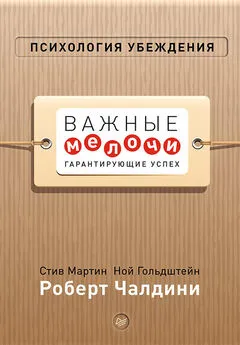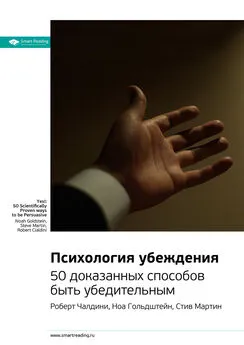Роберт Чалдини - Психология влияния. Как научиться убеждать и добиваться успеха
- Название:Психология влияния. Как научиться убеждать и добиваться успеха
- Автор:
- Жанр:
- Издательство:Питер
- Год:2014
- Город:СПб
- ISBN:978-5-496-01033-7
- Рейтинг:
- Избранное:Добавить в избранное
-
Отзывы:
-
Ваша оценка:
Роберт Чалдини - Психология влияния. Как научиться убеждать и добиваться успеха краткое содержание
«Психология влияния» — одно из лучших учебных пособий по социальной психологии, конфликтологии, менеджменту, по мнению большинства западных и отечественных психологов. Книга Роберта Чалдини выдержала в США пять изданий, ее тираж давно уже превысил два миллиона экземпляров. Эта работа, подкупающая читателя легким стилем и эффектной подачей материала, — серьезный труд, в котором на самом современном уровне анализируются механизмы мотивации, усвоения информации и принятия решений.
Новое, переработанное и дополненное, издание международного бестселлера займет достойное место в библиотеке психолога, менеджера, педагога, политика — каждого, кто по роду деятельности должен убеждать, воздействовать, оказывать влияние.
Психология влияния. Как научиться убеждать и добиваться успеха - читать онлайн бесплатно ознакомительный отрывок
Интервал:
Закладка:
Kahneman, D., Slovic, P., Tversky, A. (Eds.). (1982). Judgment under uncertainty: Heuristics and biases. New York: Cambridge University Press.
Kamisar, Y. (1980). Police interrogation and confession: Essays in law and policy. Ann Arbor: University of Michigan Press.
Katzev, R., Johnson, T. (1984). Comparing the effects of monetary incentives and foot-in-the- door strategies in promoting residential electricity conservation. Journal of Applied Psychology, 14 , 12–27.
Katzev, R., Pardini, A. (1988). The comparative effectiveness of token reinforcers and personal commitment in promoting recycling. Journal of Environmental Systems, 17 , 93–113.
Keinan, G. (1987). Decision making under stress: Scanning of alternatives under controllable and uncontrollable threats. Journal of Personality and Social Psychology, 52 , 639–644.
Kenrick, D.T., Keefe, R.C. (1992). Age preferences in mates reflect sex differences in human reproductive strategies. Brain and Behavioral Sciences, 15 , 75–133.
Kenrick, D.T., Gutierres, S.E., Goldberg, L.L. (1989). Influence of popular erotica on judgments of strangers and mates. Journal of Experimental Social Psychology, 25 , 159–167.
Kerr, N.L., MacCoun, R.J. (1985). The effects of jury size and polling method on the process and product of jury deliberation. Journal of Personality and Social Psychology, 48, 349–363.
Ketelaar, T. (1995, June). Emotions as mental representations of gains and losses: Translating prospect theory into positive and negative affect. Paper presented at the meeting of the American Psychological Society, New York, NY.
Kissinger, H. (1982). Years of upheaval. Boston: Little, Brown.
Knishinsky, A. (1982). The effects of scarcity of material and exclusivity of information on industrial buyer perceived risk in provoking a purchase decision. Unpublished doctoral dissertation, Arizona State University, Tempe.
Knouse, S.B. (1983). The letter of recommendation: Specificity and favorability information. Personal Psychology, 36, 331–341.
Knox, R.E., Inkster, J.A. (1968). Postdecisional dissonance at post time. Journal of Personality and Social Psychology, 8, 319–323.
Kraut, R.E. (1973). Effects of social labeling on giving to charity. Journal of Experimental Social Psychology, 9 , 551–562.
Kruglanski, A.E., Freund, T. (1983). The freezing and unfreezing of lay inferences: Effects on impressional primacy, ethnic stereotyping, and numerical anchoring. Journal of Experimental Social Psychology, 19 , 448–468.
Kulka, R.A., Kessler, J.R. (1978). Is justice really blind? The effect of litigant physical attractiveness on judicial judgment. Journal of Applied Social Psychology, 4, 336–381.
Kunz, P.R., Woolcott, M. (1976). Season’s greetings: From my status to yours. Social Science Research, 5 , 269–278.
Kurtzburg, R.L., Safar, H., Cavior, N. (1968). Surgical and social rehabilitation of adult offenders. Proceedings of the 76th Annual Convention of the American Psychological Association, 3 , 649–650.
Lack, D. (1943). The life of the robin. London: Cambridge University Press.
Langer, E., Blank, A., Chanowitz, B. (1978). The mindlessness of ostensibly thoughtful action: The role of «placebic» information in interpersonal interaction. Journal of Personality and Social Psychology, 36, 635–642.
Langer, E.J. (1989). Minding matters. In L. Berkowitz (Ed.), Advances in experimental social psychology (Vol. 22). New York: Academic Press.
Langlois, J.H., Kalakanis, A., Rubenstein, A.J., Larson, A., Hallam, M., Smoot, M. (2000). Maxims or myths of beauty: A meta-analytic and theoretical review. Psychological Bulletin, 126, 390–423.
Latane, B., Darley, J.M. (1968a). Group inhibition of bystander intervention in emergencies. Journal of Personality and Social Psychology, 10, 215–221.
Latane, B., Darley, J.M. (1968b). The unresponsive bystander: Why doesn’t he help? New York: Appleton-Century-Crofts.
Latane, B., Nida, S. (1981). Ten years of research on group size and helping. Psychological Bulletin, 89, 308–324.
Latane, B., Rodin, J. (1969). A lady in distress: Inhibiting effects of friends and strangers on bystander intervention. Journal of Experimental Social Psychology, 5 , 189–202.
Laughlin, P.R. (1980). Social combination processes in cooperative problem-solving groups in verbal intellective tasks. In M. Fishbein (Ed.), Progress in social psychology. Hillsdale, NJ: Lawrence Erlbaum.
Leakey, R., Lewin, R. (1978). People of the lake. New York: Anchor Press/Doubleday.
Lee, F., Peterson, C., Tiedens, L.Z. (2004). Mea culpa: Predicting stock prices from organizational attributions. Journal of Personality and Social Psychology, 30, 1636–1649.
Lee, K.M., Nas, C. (2004). The multiple source effect and synthesized speech: Doubly disembodied language as a conceptual framework. Human Communication Research, 30, 182–207.
Lefkowitz, M., Blake, R.R., Mouton, J.S. (1955). Status factors in pedestrian violation of traffic signals. Journal of Abnormal and Social Psychology, 51 , 704–706.
Leippe, M.R., Elkin, R.A. (1987). When motives clash: Issue involvement and response involvement as determinants of persuasion. Journal of Personality and Social Psychology, 52 , 269–278.
Lepper, M.R., Greene, D. (Eds.). (1978). The hidden costs of reward. Hillsdale, NJ: Lawrence Erlbaum.
Li, W., Moallem, L., Paller, K.A., Gottfried, J.A. (2007). Subliminal smells can guide social preferences. Psychological Science, 18, 1044–1049.
Lieberman, J.D., Arndt, J. (2000). Understanding the limits of limiting instructions. Psychology, Public Policy, and Law, 6 , 677–711.
Liebert, R., Baron, R.A. (1972). Some immediate effects of televised violence on children’s behavior. Developmental Psychology, 6, 469–475.
Lloyd, J.E. (1965). Aggressive mimicry in Photuris: Firefly femme fatales. Science, 149 , 653–654.
Locke, K.S., Horowitz, L.M. (1990). Satisfaction in interpersonal interactions as a function of similarity in level of dysphoria. Journal of Personality and Social Psychology, 58 , 823–831.
Lott, A.J., Lott, B.E. (1965). Group cohesiveness as interpersonal attraction: A review of relationships with antecedent and consequent variables. Psychological Bulletin, 64, 259–309.
Lun, J., Sinclair, S., Whitchurch, E.R., Glenn, C. (2007). (Why) do I think what you think? Epistemic social tuning and implicit prejudice. Journal of Personality and Social Psychology, 93, 957–972.
Lynn, M. (1989). Scarcity effect on value: Mediated by assumed expensiveness. Journal of Economic Psychology, 10, 257–274.
Lynn, M., Shurgot, B.A. (1984). Responses to lonely hearts advertisements: Effects of reported physical attractiveness, physique, and coloration. Personality and Social Psychology Bulletin, 10, 349–357.
Lytton, J. (1979). Correlates of compliance and the rudiments of conscience in two-year-old boys. Canadian Journal of Behavioral Science, 9 , 242–251.
Mack, D., Rainey, D. (1990). Female applicants’ grooming and personnel selection. Journal of Social Behavior and Personality, 5 , 399–407.
MacKenzie, B. (1974, June 22). When sober executives went on a bidding binge. TV Guide.
Mackworth, N.H. (1965). Visual noise causes tunnel vision. Psychonomic Science, 3 , 67–68.
Macrae, N. (1972, January 22). Multinational business. The Economist.
Magruder, J.S. (1974). An American life: One man’s road to Watergate. New York: Atheneum.
Major, B., Carrington, P.I., Carnevale, P.J. D. (1984). Physical attractiveness and self-esteem: Attributions for praise from an other-sex evaluator. Personality and Social Psychology Bulletin, 10 , 43–50.
Manis, M., Cornell, S.D., Moore, J.C. (1974). Transmission of attitude relevant information through a communication chain. Journal of Personality and Social Psychology, 30 , 81–94.
Markus, H., Kitayama, S. (1991). Culture and the self: Implications of cognition, emotion, and motivation. Psychological Bulletin, 98, 224–253.
Mather, M., Shafir, E., Johnson M.K. (2000). Misremembrance of options past: Source monitoring and choice. Psychological Science, 11, 132–138.
Mauro, R. (1984). The constable’s new clothes: Effects of uniforms on perceptions and problems of police officers. Journal of Applied Social Psychology, 14, 42–56.
Mauss, M. (1954). The gift. (I. G. Cunnison, Trans.). London: Cohen and West.
Mazis, M.B. (1975). Antipollution measures and psychological reactance theory: A field experiment. Journal of Personality and Social Psychology, 31 , 654–666.
Mazis, M.B., Settle, R.B., Leslie, D.C. (1973). Elimination of phosphate detergents and psychological reactance. Journal of Marketing Research, 10, 390–395.
McCall, M., Belmont, H.J. (1996). Credit card insignia and restaurant tipping: Evidence for an associative link. Journal of Applied Psychology, 81, 609–613.
McGuinnies, E., Ward, C.D., (1980). Better liked than right: Trustworthiness and expertise as factors in credibility. Personality and Social Psychology Bulletin, 6, 467–472.
McKensie, C.R. M., Chase, V.M. (in press). Why rare things are precious: The importance of rarity in lay inference. In P.M. Todd, G. Gigerenzer &The ABC Research Group (Eds.), Ecological rationality: Intelligence in the world. Oxford: Oxford University Press.
Meeus, W.H. J., Raaijmakers, Q.A. W. (1986). Administrative obedience: Carrying out orders to use psychological-administrative violence. European Journal of Social Psychology, 16, 311–324.
Melamed, B. R, Yurcheson, E., Fleece, L., Hutcherson, S., Hawes, R. (1978). Effects of film modeling on the reduction of anxiety-related behaviors in individuals varying in level of previous experience in the stress situation. Journal of Consulting and Clinical Psychology, 46, 1357–1374.
Meyerwitz, B.E., Chaiken, S. (1987). The effect of message framing on breast self-examination attitudes, intentions, and behavior. Journal of Personality and Social Psychology, 52 , 500–510.
Milgram, S. (1963). Behavioral study of obedience. Journal of Abnormal and Social Psychology, 67 , 371–378.
Milgram, S. (1970). The experience of living in cities. Science, 13, 1461–1468.
Milgram, S. (1974). Obedience to authority. New York: Harper & Row.
Milgram, S., Bickman, L., Berkowitz, O. (1969). Note on the drawing power of crowds of different size. Journal of Personality and Social Psychology, 13, 79–82.
Miller, N., Campbell, D.T., Twedt, H., O’Connell, E.J. (1966). Similarity, contrast, and complementarity in friendship choice. Journal of Personality and Social Psychology,3 , 3–12.
Miller, R.L., Seligman, C., Clark, N.T., Bush, M. (1976). Perceptual contrast versus reciprocal concession as mediators of induced compliance. Canadian Journal of Behavioral Science, 8, 401–409.
Mills, C.M., Keil, F.C. (2005). The development of cynicism. Psychological Science, 16, 385–390.
Mills, J., Clark, M.S. (1982). Exchange and communal relationships. In L. Wheeler (Ed.), Review of personality and social psychology (Vol. 3). Beverly Hills, CA: Sage Publications.
Читать дальшеИнтервал:
Закладка:










